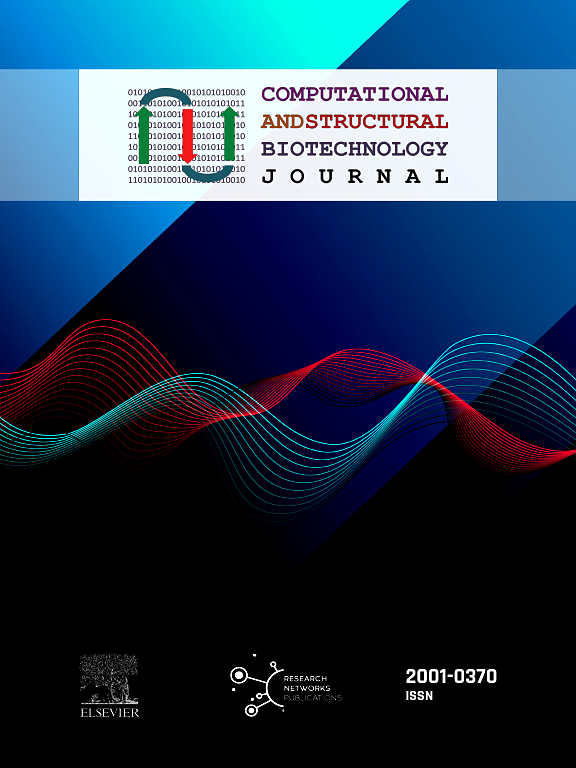奇妙的基因在CHO中表达
IF 4.4
2区 生物学
Q2 BIOCHEMISTRY & MOLECULAR BIOLOGY
Computational and structural biotechnology journal
Pub Date : 2025-04-02
DOI:10.1016/j.csbj.2025.03.050
引用次数: 0
摘要
中国仓鼠卵巢(CHO)细胞的转录组在决定生物制药应用所必需的细胞特征方面起着至关重要的作用。RNA 测序已被广泛用于分析基因表达模式,旨在更好地了解细胞内的行为和机制。然而,单个数据集无法提供 CHO 细胞转录组的全面概述和特征,因此转录组的基本结构仍然未知。我们利用 15 个 RNA 测序数据集(包括不同实验设置、条件和细胞系的近 300 个样本),对 CHO 细胞的蛋白质编码转录组进行了探索和分类。我们发现细胞系的差异是转录基因变异的主要来源。通过采用一种新方法,我们确定了在所有细胞系和培养条件下普遍表达的核心转录组,以及完全不表达的基因。此外,我们还发现了一组基因,它们在不同条件下可能活跃或不活跃,这与包括翻译以及免疫和应激反应在内的生物过程有关。最后,通过整合组蛋白修饰得出的染色质状态,我们在表观遗传水平上提供了额外的背景,为我们的蛋白编码基因分类提供了支持。我们的研究提供了对 CHO 细胞转录组的全面了解,为今后研究细胞对变化条件的适应以及表型的发展奠定了基础。本文章由计算机程序翻译,如有差异,请以英文原文为准。

Fantastic genes and where to find them expressed in CHO
The transcriptome of Chinese hamster ovary (CHO) cells plays a crucial role in determining cellular characteristics that are essential for biopharmaceutical applications. RNA-sequencing has been extensively used to profile gene expression patterns, aiming to gain a better understanding of intracellular behavior and mechanisms. Individual datasets, however, do not provide a comprehensive overview and characterisation of the CHO cell's transcriptome, such that the fundamental structure of the transcriptome remains unknown. Using 15 RNA-sequencing datasets, encompassing almost 300 samples of various experimental setups, conditions and cell lines, we explore and classify the protein-coding transcriptome of CHO cells. Differences in cell line lineages are found to be the primary source of variation in transcribed genes. By employing a novel approach, we identified the core transcriptome that is ubiquitously expressed in all cell lines and culture conditions, as well as genes that remain entirely non-expressed. Additionally, we identified a set of genes that may be active or inactive depending on different conditions, which are linked to biological processes including translation as well as immune and stress response. Lastly, by integrating chromatin states derived from histone modifications, we provided additional context on the epigenetic level that supports our protein-coding gene classification. Our study offers a comprehensive insight into the CHO cell transcriptome and lays the foundation for future research into cellular adaptation to changing conditions and the development of phenotypes.
求助全文
通过发布文献求助,成功后即可免费获取论文全文。
去求助
来源期刊

Computational and structural biotechnology journal
Biochemistry, Genetics and Molecular Biology-Biophysics
CiteScore
9.30
自引率
3.30%
发文量
540
审稿时长
6 weeks
期刊介绍:
Computational and Structural Biotechnology Journal (CSBJ) is an online gold open access journal publishing research articles and reviews after full peer review. All articles are published, without barriers to access, immediately upon acceptance. The journal places a strong emphasis on functional and mechanistic understanding of how molecular components in a biological process work together through the application of computational methods. Structural data may provide such insights, but they are not a pre-requisite for publication in the journal. Specific areas of interest include, but are not limited to:
Structure and function of proteins, nucleic acids and other macromolecules
Structure and function of multi-component complexes
Protein folding, processing and degradation
Enzymology
Computational and structural studies of plant systems
Microbial Informatics
Genomics
Proteomics
Metabolomics
Algorithms and Hypothesis in Bioinformatics
Mathematical and Theoretical Biology
Computational Chemistry and Drug Discovery
Microscopy and Molecular Imaging
Nanotechnology
Systems and Synthetic Biology
 求助内容:
求助内容: 应助结果提醒方式:
应助结果提醒方式:


